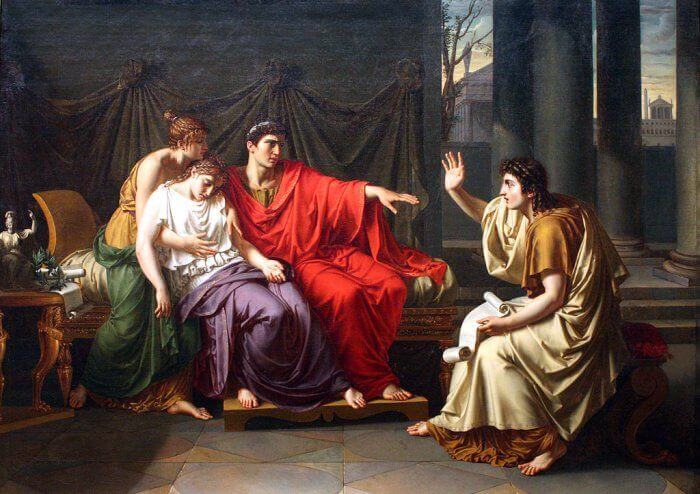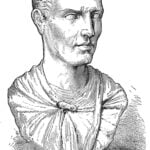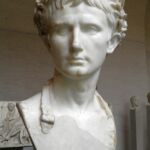Chapters
Virgil was born on October 15, 70 BCE in the village of Andes near Mantua in Pre-Alpine Gaul, under the names of Publius Vergilius Maro., During the first consulate of Pompey and Crassus. An outstanding poet, the greatest Roman epic.
Virgil’s biography is relatively well known, incl. thanks to the biography of Donat’s pen from the 4th century CE.
Origin and beginnings of a literary career
The poet’s family house was situated on the Mincius River, hence the nickname Minciades was used for the poet. He had three younger brothers, of whom only one (half-step), Valerius Proculus, survived him. The poet’s father was, according to some sources, a potter, according to others, a servant of the janitor Magius, whose daughter – Magic Polla – he married. Thanks to the help of his father-in-law and his own diligence, the poet’s father bought a small estate in Andes (according to modern tradition, Virgilio or Pietole Vecchia) near Mantua. That is why Virgil was also called Mantuanus or Andinus. According to later legend, from the beginning, Virgil’s life was marked by miraculous events. As a baby, he did not cry, and the poplar branch that was put into the ground for his birthday soon grew to an enormous size.
The cultivation of the land, as well as the breeding of bees, made the family relatively prosperous. Father sent young Virgil to school, not in nearby Mantua, but in Cremon, about 70 kilometres away, where he could learn to read and write under the guidance of better teachers (litteratori). Upon reaching the age of majority, in CE 55 (as some biographers claim – on the day Lucretius died), Virgil left for further studies in Milan, where he studied with grammarians (grammatici).
In 53 CE he moved to Naples, where he took lessons in rhetoric and philosophy from the Greeks. Donat gave two names of the poet’s teachers. The first was the unknown Epidius – a rhetorician who was also to be educated by Octavian, who was seven years his junior. The second was Syron, an Epicurean from Naples, a student of Philodemos of Gadara (the teacher of Cicero). Some scholars believe that Virgil also studied with the poet Parthenios of Nice.
Under the influence of Syron, Virgil fell under the spell of Epicurus’ teachings, which he reflected in one of his youthful poems.
After a few years, Virgil abandoned his interest in epicureanism in favour of the philosophy of the Stoics. Throughout his life, he emphasized his love for philosophy, and from his youth, he planned a trip to Greece to devote himself to philosophical reflections.
In Naples it turned out that Virgil did not have rhetorical talents. At the end of 53, he resigned from further studies and went to Rome. He tried his hand as an attorney and speaker. He turned out to be harsh, unconvincing rhetoric, and he was burned by stage fright before every public performance. On the other hand, at small meetings with friends, when he began to speak in verse, his language – as the witnesses of these events quoted by Donat reported – transformed into a wonderful, seductive sweetness.
In Rome, he approached a group of writers known as neotericists. He had a particularly close relationship with the poets Cornelius Gallus and Azynius Pollion, and the lawyer from Cremona, Alfenus Varus. During the first years of his stay in the capital, he wrote his youthful pieces, later collected in the collection Trinkets. According to some researchers, after unsuccessful attempts to start a career as a clerk, who already had some poetic achievements, Virgil said goodbye to his friends and Rome for financial and health reasons. He moved back to Naples, where he settled permanently.
Around the mid of 40s, Virgil began to write bucolic works, which were collected and published as a poem in the 30s. According to Servius and some contemporary researchers, the poet’s first publicly presented work was a poem, which was later classified as Bukolik in the collection Bukolik as Eklog VI. Cicero refers to this work in Rozmowy Tuskulańskich and About God’s Signs, hence the event Servius wrote about usually dates back to the year 45. As part of a musical interlude, during a theatrical performance in Rome, a song sounded, accompanied by dance performances. It was performed by the most popular actress at the time, the generally recognized beauty of Volumnia – also known under the pseudonyms Kyteris or Lycoris. Her lover, the poet Cornelius Gallus, praised her under the latter name. That evening, a special piece of eighty-six hexameters was prepared by Virgil for Volumnia.
The piece was peculiar at that time, mainly due to the wealth of incredible stories it contained. Three men overwhelmed the old satire Silen who was sleeping off his alcoholic binge. The satyr bought himself out by chanting a song that had an impact on all surrounding nature. In it, he sang about the history of mankind, touching on, among other things, the origins of the universe from atoms, the deluge, or the theft of fire by Prometheus. Then he suddenly turned to examples of unhappy loves that affected the fate of the world. At the climax of the song, Sylen paused longer to express his sorrow over the love passion of the Queen of Crete, who had fallen in love with a bull. In moving lines he praised Kretenka’s jealousy of the cow. In the final fragments of the satires, he already talked about the contemporary Roman reality – Gallus’ love for Lycoris. After the song ended, Silenus reportedly continued to sing until nightfall, but Lykoris had finished her line after a few lines.
The peculiarity of the work, however, was not only due to its content. The verses sounded surprisingly soft, and at the same time – for all their harmonics – had at the same time a Roman dignity that in the two hundred years of Latin poetry had not been heard before.
Confiscations
In 42 BCE, after the Battle of Philippi, estates near Mantua were to be parcelled out to veterans. Mantua, adjacent to the Cremon, was also expropriated. Among others, the land of Virgil’s family was allocated to the parcelling for the benefit of the veterans. According to some researchers, the whole family then found refuge in the villa of the philosopher Syron near Naples. Virgil, however, regained the land thanks to the help of his friends – Alfenus Varus, Gallus and Pollion – who were commissioned by Octavian to carry out the parcelling. Virgil’s friend was also the chief surveyor Octavius Musa. According to several accounts, the poet was to personally apply to Augustus himself to withdraw the deportation order.
Some scholars, however, believe that Virgil’s fortune was taken twice. Initially, thanks to the intercession of kind commissioners and Octavian, the family stayed where it was. However, the outbreak of the so-called of Peruvian War in 40 CE, accelerated the parcelling of land in Cisalpina Gaul, which resulted in a further and final loss of land by Virgil’s family. About the same time, the poet’s father died, distressed by the parcelling. Virgil never returned to Mantua. He settled permanently in Naples but often stayed in Rome.
However, he did not return to his homeland, he settled in Rome. There he found himself in the environment of the tutor of poets Patron, to which he introduced Horace, with which he was fascinated.
Creativity
At that time, he gained publicity thanks to a collection of 10 idylls “Bukolik” (Eclogae or Bucolica), which he wrote in the years 42-39 BCE. They were modelled on Teokryta’s “Idylls” adapted to the realities of Italy. This species originated in the Hellenistic period and came from Alexandria. As a rule, the eclogues (the name of the poems) described the idyllic life of shepherds who made their time by singing songs, most often about love. In the first idyll, a conversation takes place between two farmers who have been expropriated from their lands. One of them went to the capital and there received grace from the “divine young man”. From now on, he promises to worship him and make sacrifices twelve times a year. As it turns out, this is an element of Virgil’s autobiography. The land belonging to the poet’s family was once confiscated in order to be able to hand it over to Octavian’s veterans. The author of “Aeneid”, however, went to Rome and asked the grace of Augustus himself. From then on, he became his lifelong debtor and glorified his name.
Work on another work “Georgics” (Georgica), in 4 books, lasted from 36 to 29 BCE. The poet wanted to pay off his debt to Octavian. This work is a didactic poem and illustrates a return to ancient Roman customs. The author approves of rural life and farm work. The piece itself begins with a dedication to Patron, and later in the poem, Virgil praises the princeps himself. Virgil, in accordance with the views of his principals, focused on promoting ancient Roman virtue in the Roman nation. To this end, he described the hard and arduous work of the farmers in a beautiful and glorious manner. The author wanted to show an ideal world, where his own hard work in accordance with the harmony of nature guarantees an idyllic life. But how different was then the life of the average Roman small farmer. They struggled to compete with the great estates of patricians. Often the debts they fell into forced them to decide to sell their property and become a slave of their larger neighbour. At the end of the republic, the practice of confiscating farmers’ lands and handing them over to war veterans was common.
The decline of Virgil’s life is filled with the work on his greatest work – “Aeneid” (Aeneis) in 12 books, which he did not manage to finish. This great epic, modelled on Homeric works, celebrated the mythical origins of Rome. Aeneid was to grace the past of Rome and the Julian family, which Virgil proved his great propaganda skills. The story briefly describes how the main character of the epic – Aeneas – sails away with his companions from the devastated Troy to seek a new settlement for his people. After years of wandering, a series of adventures and fights, they manage to reach a new land, which turns out to be Italy. All this is due to the favour of the gods and their will. The epic, born of the spirit of Stoic philosophy, full of faith in God’s providence, showed the greatness of Rome and its historical mission. Soon Aeneida became the primary school reading, a source of knowledge about language, poetics and rhetorical art.
Before his death, in 19 BCE, Virgil went on a journey to Greece and Asia Minor, but due to ill health, he was forced to interrupt his journey in Athens and return to Italy.
Death
He died on September 21, 19 BCE in Brundysium at the age of 51. His body was buried in Naples. He left behind a considerable fortune: a house in Rome and numerous country estates. According to the will, the publication of Aeneid was to be prevented. The poet believed that this work was not yet finished. However, on the command of Octavian Augustus this work was released.
Under the name of Virgil, antiquity also donated a collection of small works, the so-called Appendix Vergiliana. According to ancient commentators, these are the youthful writings of Virgil, but their authorship is disputed.
Virgil’s Tomb, located in an old Roman tunnel called grotta vecchia in Naples, has been a place of worship and pilgrimage for centuries. Probably the church of St. Mary of Piedigrotta (Chiesa della Santa Maria di Piedigrotta) was built near the tomb to neutralize the older cult. In the Middle Ages it was believed that Virgil in the Bucolics had foretold the coming of Jesus.











